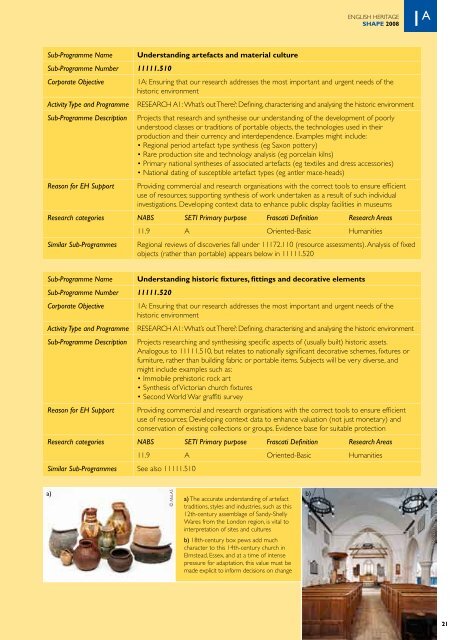shape | pdf - English Heritage
shape | pdf - English Heritage
shape | pdf - English Heritage
You also want an ePaper? Increase the reach of your titles
YUMPU automatically turns print PDFs into web optimized ePapers that Google loves.
english heritage<br />
<strong>shape</strong> 2008<br />
1 A<br />
Sub-Programme Name<br />
Sub-Programme Number 11111.510<br />
Corporate Objective<br />
Activity Type and Programme<br />
Sub-Programme Description<br />
Reason for EH Support<br />
Understanding artefacts and material culture<br />
1A: Ensuring that our research addresses the most important and urgent needs of the<br />
historic environment<br />
RESEARCH A1: What’s out There?: Defining, characterising and analysing the historic environment<br />
Projects that research and synthesise our understanding of the development of poorly<br />
understood classes or traditions of portable objects, the technologies used in their<br />
production and their currency and interdependence. Examples might include:<br />
• Regional period artefact type synthesis (eg Saxon pottery)<br />
• Rare production site and technology analysis (eg porcelain kilns)<br />
• Primary national syntheses of associated artefacts (eg textiles and dress accessories)<br />
• National dating of susceptible artefact types (eg antler mace-heads)<br />
Providing commercial and research organisations with the correct tools to ensure efficient<br />
use of resources; supporting synthesis of work undertaken as a result of such individual<br />
investigations. Developing context data to enhance public display facilities in museums<br />
Research categories NABS SETI Primary purpose Frascati Definition Research Areas<br />
Similar Sub-Programmes<br />
11.9 A Oriented-Basic Humanities<br />
Regional reviews of discoveries fall under 11172.110 (resource assessments). Analysis of fixed<br />
objects (rather than portable) appears below in 11111.520<br />
Sub-Programme Name<br />
Sub-Programme Number 11111.520<br />
Corporate Objective<br />
Activity Type and Programme<br />
Sub-Programme Description<br />
Reason for EH Support<br />
Understanding historic fixtures, fittings and decorative elements<br />
1A: Ensuring that our research addresses the most important and urgent needs of the<br />
historic environment<br />
RESEARCH A1: What’s out There?: Defining, characterising and analysing the historic environment<br />
Projects researching and synthesising specific aspects of (usually built) historic assets.<br />
Analogous to 11111.510, but relates to nationally significant decorative schemes, fixtures or<br />
furniture, rather than building fabric or portable items. Subjects will be very diverse, and<br />
might include examples such as:<br />
• Immobile prehistoric rock art<br />
• Synthesis of Victorian church fixtures<br />
• Second World War graffiti survey<br />
Providing commercial and research organisations with the correct tools to ensure efficient<br />
use of resources; Developing context data to enhance valuation (not just monetary) and<br />
conservation of existing collections or groups. Evidence base for suitable protection<br />
Research categories NABS SETI Primary purpose Frascati Definition Research Areas<br />
Similar Sub-Programmes See also 11111.510<br />
11.9 A Oriented-Basic Humanities<br />
a)<br />
a) The accurate understanding of artefact<br />
traditions, styles and industries, such as this<br />
12th-century assemblage of Sandy-Shelly<br />
Wares from the London region, is vital to<br />
interpretation of sites and cultures<br />
b)<br />
© MoLAS<br />
b) 18th-century box pews add much<br />
character to this 14th-century church in<br />
Elmstead, Essex, and at a time of intense<br />
pressure for adaptation, this value must be<br />
made explicit to inform decisions on change<br />
© Patricia Payne, <strong>English</strong> <strong>Heritage</strong><br />
21

















